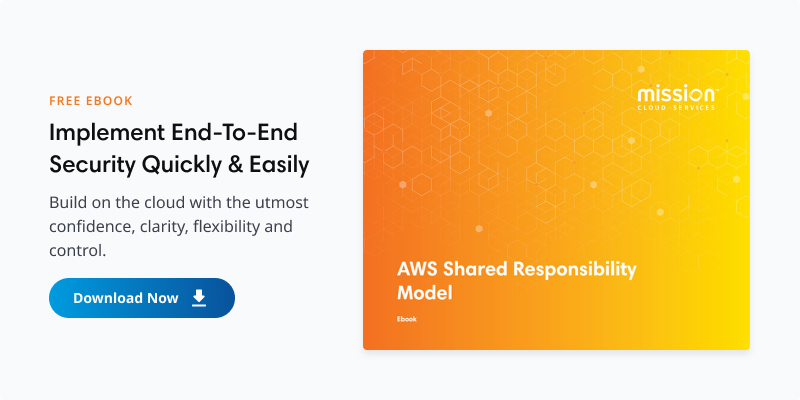Blog
What is AWS Network Firewall and Why Should You Use It?
With cyberattacks increasing daily, it’s crucial to protect your application with a firewall. Network firewalls protect your application from threats like malware, botnets, and DDoS attacks while providing advanced access control.
There are two ways to add an advanced firewall to your network: with a security appliance and with a software-based firewall. The traditional enterprise approach involves routing network traffic through a physical network security appliance. These appliances work well, but they're expensive.
Software-based firewalls are the other option, and they’re growing increasingly popular because they offer several advantages. Cost is a big one: software-based firewalls are typically much less expensive than hardware-based network appliances. They’re also easier to set up and have a shallower learning curve.
If you're running applications on Amazon Web Services (AWS), AWS Network Firewall is a natural choice. It’s a software-based, highly available, managed firewall service for the entire Amazon Virtual Private Cloud (VPC). It integrates well with other AWS services and offers stateful and stateless inspection, intrusion prevention, and web-traffic filtering features. AWS Network Firewall sits in front of your AWS VPC so it can inspect all traffic entering or leaving your network.
Let’s discuss why you might use AWS Network Firewall and how to deploy it.

Why Use AWS Network Firewall?
Many companies use the AWS Web Application Firewall (WAF) to protect their website from unwanted threats. This is great! Still, AWS Network Firewall goes further by handling all types of traffic — not just network traffic.
Additionally, AWS Network Firewall provides extra features including deep packet inspection, application protocol detection, domain name filtering, and an intrusion prevention system. WAF, in contrast, can’t handle these features because it works on a different open systems intercommunication (OSI) model layer.
If your organization uses various AWS services, you’ll have a seamless transition to working with AWS Network Firewall. It’s compatible with AWS Direct Connect, AWS Simple Storage Service (S3), AWS Kinesis, AWS Firewall Manager, and AWS Organizations, among others.
Who Needs AWS Network Firewall?
AWS Network Firewall allows you to fulfill network protection and access prevention requirements within a few clicks. So, if you use AWS Services, and you find yourself the target of malicious attacks or have a malware problem, AWS Network Firewall may be the right choice for you.
Third-party applications like Palo Alto also fulfill protection requirements, but their installation requires upfront investment and can be challenging. AWS Network Firewall is a cost-effective alternative. It integrates better and more easily with various AWS services, adding tremendous value, minimizing cost, and saving you time. AWS Network Firewall is a wise choice if you’re on a tight budget, and if you’re looking for convenient yet protective network measurements.
You want your organization’s firewall services to be the most reliable to provide the best security. AWS Network Firewall is highly available and has a service-level agreement of 99.99% uptime. Also, it scales to meet your traffic requirements without affecting performance and security. Its active traffic flow inspection with real-time packet scanning helps prevent exposure to brute force attacks.
As it sits at the edge of AWS VPC, AWS Network Firewall helps control outgoing traffic. It can route requests from public or private subnet resources before exposure to outside Internet users.
If you want to keep the logs for compliance, you can store them on AWS S3’s affordable and reliable object-based storage solution. Additionally, various third-party integration provides room for analysis, monitoring, and rapid counter measurements. For example, you can integrate AWS Network Firewall with Datadog to detect anomalies in the traffic with a defined set of rules. If network traffic violates the rule, Datadog can quickly send alerts for rapid resolution.
Also, the AWS Network Firewall creates policies and policy groups. These policies are portable between AWS accounts and organizations. After you develop the rules, there’s no need to reinvent the wheel — you’re set for the future. Also, it supports Suricata-compatible rules that are created internally or sourced from third-party services.
AWS Network Firewall is a great fit for most businesses, from a starter seeking security measures to safeguard their infrastructure or application to an organization searching for extra protection for their AWS VPCs. Plus, its deployment strategies work with centralized or distributed applications or infrastructure. Now let’s look at its deployment models.
AWS Network Firewall Deployment Models
AWS Network Firewall supports three types of deployment models, depending on the use case:
- Distributed model
- Centralized model
- Combined (hybrid) model
There are subtle differences between each model, which are important when determining the suitable model for you. Centralized and combined models both support VPC to VPC traffic flow using AWS Transit Gateway. The distributed model, in contrast, doesn’t require AWS Transit Gateway. In a distributed model, every AWS VPC can have its own AWS Network Firewall, meaning you can have a different set of rules for each one. Since AWS VPCs aren’t connected, it helps reduce the blast radius.
The disadvantage of the distributed model is that it doesn’t support VPC to on-premises connection or network flow. The centralized model, on the other hand, allows connectivity between VPCs and on-premises infrastructure. Note, though, that it only has one AWS Network Firewall between all infrastructure, leading to increased blast radius.
The combined model helps eliminate the downsides of the other two models. This model enables VPC to VPC traffic flow, as well as a VPC level AWS Network Firewall for additional security measures. But this model is costly, requiring more resources.
The best model for you depends on the use cases you are trying to complete — it’s not a one-model-fits-all situation. If you don’t have to worry about on-premises infrastructure, the distributed model might work best: it’s the cheapest, easiest to set up, and most secure. However, a centralized model may suit you better, given its usefulness in complying with local laws or governance. Alternatively, if cost isn’t a concern for you, the combined model may be the most appropriate, providing more policy control and higher resistance against the threats.
Safeguard Your Applications
AWS Network Firewall is invaluable for safeguarding your infrastructure and application. It provides more features and functions than a traditional WAF. Plus, it protects against web traffic and provides deep packet inspections, domain filtering, and intrusion prevention.
AWS Network Firewall directly integrates with multiple AWS and third-party services. Whether you need protection against DDoS attacks or the ability to determine brute force attacks against the system, AWS Network Firewall can be the ideal choice. The portable nature of access control policies and policy groups makes sharing it across organizations or AWS accounts easy: You can create them once and use them everywhere. AWS Network Firewall also has three deployment modes to suit your enterprise’s needs.
Throughout this article, we reviewed AWS Network Firewall’s ability to apply preventive measures. But wouldn’t it be awesome if you could detect threats and use preventative measures automatically? Check out Mission Managed Detection and Response service and contact Mission to learn more about how we can fully manage your threat detection and response.

FAQ
How does AWS Network Firewall's performance impact network throughput and latency in real-world applications?
The performance of AWS Network Firewall on network throughput and latency in real-world applications is generally optimized to ensure minimal impact. The service is designed to scale with your traffic flow, ensuring that security measures do not become bottlenecks. However, like any advanced network inspection service, certain configurations, especially those involving deep packet inspection or complex stateful inspection rules, can introduce some latency. The extent of this impact can vary depending on the specific configurations, the volume of traffic, and the complexity of the rules applied. Can AWS Network Firewall be integrated with third-party security services and tools for enhanced security postures?
Can AWS Network Firewall be integrated with third-party security services and tools for enhanced security postures?
AWS Network Firewall can be integrated with third-party security services and tools, enhancing your security posture beyond its native capabilities. This is facilitated through AWS's extensive API ecosystem, allowing for automation and integration with external threat intelligence feeds, SIEM systems, and orchestration tools. Such integrations enable more comprehensive security solutions, leveraging AWS Network Firewall's capabilities alongside other security products to provide layered defenses against a broader range of threats.
What are the specific configuration and management challenges one might face when deploying and maintaining AWS Network Firewall in a complex AWS environment?
Deploying and maintaining AWS Network Firewall in a complex AWS environment presents configuration and management challenges. These include setting up the firewall across multiple VPCs, ensuring correct traffic routing through the firewall endpoints, and maintaining the firewall rules and policies in sync with the evolving security landscape and organizational policies. Additionally, ensuring high availability and fault tolerance within the AWS Network Firewall setup requires careful planning and configuration, particularly in environments with stringent uptime requirements. Effective management of these aspects often necessitates a deep understanding of AWS networking and security best practices and ongoing monitoring and optimization to adapt to changing traffic patterns and threats.
Author Spotlight:
Juan Cortes
Keep Up To Date With AWS News
Stay up to date with the latest AWS services, latest architecture, cloud-native solutions and more.

